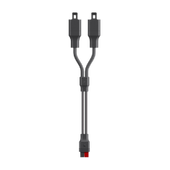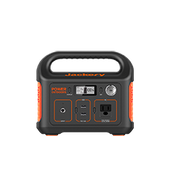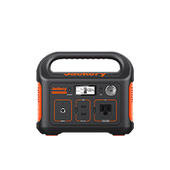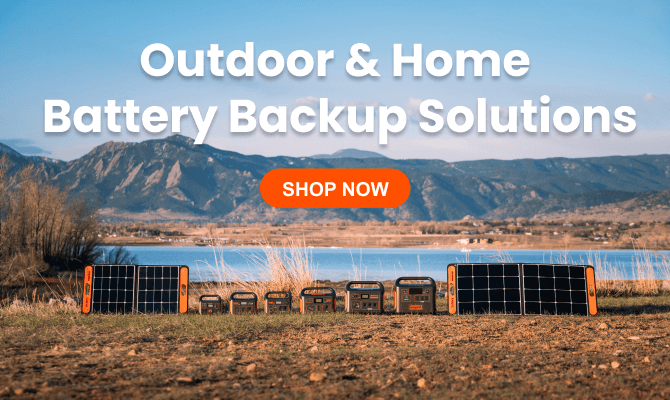Living in a car isn't entirely different from an extended car camping. Car living has evolved beyond short-term escape into a way of life. If you have decided to spend days or weeks traveling on four wheels, you must carry essential gear to stay safe, sane, and comfortable.
For example, you would need a decent camping mattress or a camp-friendly sleeping pad for a comfortable sleep. You'll also need a solar-powered generator like Jackery Solar Generator to charge most of your car camping essentials, such as a cooking grill, portable coffee machines, fans, lights, laptops, and more.
Key Takeaways
- Living in a car can dramatically reduce your living expenses and give you the freedom to move around.
- Some important car living essentials include documents, car insurance, a cooler, clothing, and a power supply source like Jackery Solar Generators.
- You can park your car on public lands, your own land, campsites, Walmart car parks, trucker spots, welcome centers, and your friend's property.
- Living in a car requires understanding the sleeping arrangements, focusing on personal hygiene, and investing in a power supply.
Why Live in a Car
Many people are giving up their apartments to try off-grid living in a car. The core benefits of living in a vehicle include financial freedom, simplicity, and mobility. When you live in a car, you don't have to pay the landlord for the apartment and the utility company for gas and electricity. If traveling is your first priority, consider living in a car. You can explore the unexplored land and experience the nomadic lifestyle.
Plus, the confined space in the car encourages you to experience a minimalist lifestyle and reduce the amount of stuff you'll need. One thing to note is that no federal or state law prohibits sleeping in a car. However, many municipalities and cities have specific rules related to car living. For instance, camping overnight on public property, such as parks, is generally illegal. Here are some other things you would need to know:
- Sleeping in a car or any other vehicle on private property that you do not own is illegal.
- If you park on any public street, you must stay within the local parking time limits (usually 72 hours).
- Sleeping in a car on property owned by cities is often illegal, but it depends on local laws.
Some other laws are against sleeping in the vehicle during certain hours (typically at night). For this reason, it is essential to check the local laws before living in a car. You will also want to abide by traffic and road laws. Since living in a vehicle involves frequent traveling, you need to ensure the license, car insurance, and vehicle registration documents are up to date.
Costs Of Living in a Car
While you'll save money on housing, there are other expenses you need to consider when living in a car. On average, two people in the US might spend around $500 - $1500 when living in a car. However, the actual cost will depend on your lifestyle, the area you live in, and other needs.
If we assume you want to keep costs of living in a car as low as possible, here's what the monthly expenses might look like:
|
Living in A Car |
Breakdowns |
|
Gas |
$100 - $300 |
|
Insurance |
$100 - $200 |
|
Water |
$20 - $40 |
|
Food |
$150 - $350 |
|
Parking |
$100 - $200 |
|
Miscellaneous |
$100 - $150 |
|
Total |
$570 - $1240 |
Living in a Car Essentials
Living in a car isn't something that everyone can follow. If you want to remain comfortable throughout the car camping trip, you need to carry the right car living essentials. For example, you will need to find a suitable car, have all the necessary documents ready, and find essential living items, cooking items, etc.
Suitable Car
The first step is finding a suitable car that suits your needs and lifestyle. For example, you may consider getting a van if you have time to research the best vehicle and want a large space. On the other hand, a windowless delivery van would work great in most cases.
They are large vans and offer a large storage room under the platform bunk. You can also consider installing a rooftop skylight or hatch for air and a rooftop rack for storage. If you're planning to travel in an old car, make sure you maintain it well.
Documents
If you are planning to live in a car, you'll need to carry documents to verify identity, residency, and insurance. For instance, you will need a valid US driver's license for proof of residency and car insurance documents. You need to have these documents readily available for police inspection.
Living Items
The basic car camping essentials for living in a vehicle include a blanket, mattress, pillow, and some other padding for comfortable sleeping. A portable and waterproof cooler can make things easier for you by storing food, drinks, and medicines. Remember, it will work efficiently when full, so make sure to add bottles of cold water if you are taking out food.
Cooking Items
Peanut butter, crackers, and tuna are great staples for food when living in a car. You need to have a food box so it does not get smashed when traveling. You'll also need gallons of water to stay hydrated in the remote location.
Remember, the lack of a refrigerator will limit the amount of food you keep at one time. If you're planning to stay away for long hours, you can also invest in portable cooking appliances such as refrigerators, microwaves, toasters, blenders, electric grills, etc., to cook fresh food.
Clothing
Generally, clothes that are easy to clean, wrinkle-free, and machine washable are ideal for car living. You can keep things simple by sticking to patterns and solid colors that can coordinate with other pieces for a perfect mix-and-match. It's best to pack versatile and multipurpose clothes to save space.
Power Supply
You will also need a portable power supply source to charge essential appliances that you might carry on outdoor adventures. For example, the Jackery Solar Generators are reliable, powerful, and portable charging solutions that power 99% of your outdoor appliances.
The solar-powered generator can power an outdoor electrical grill to cook food, a refrigerator to prevent food from spoiling, and lights to illuminate the space at night. The solar panels available can help you recharge portable power stations during outdoor adventures, such as camping or RV living.
Emergency Kit
You'll also need an emergency kit to handle the unexpected situations. The emergency car kit should have equipment that will help you in any situation when the car malfunctions.
Some essentials you'll need to carry are a first aid kit, a portable jump starter, flashlights, water and non-perishable food, a multi-tool, a fire extinguisher, navigation equipment such as a compass, and portable power stations.

Where to Park & Sleep in a Car
If you are wondering where to park and sleep in your car legally, there are many options available. Let's explain the most popular parking and sleeping options when traveling in a car.
Public Land
Public lands—including BLM land, national parks, and national forests—are common places to park your car. They are also getaways for biking, hiking, boating, fishing, and hunting adventures. Bringing an inflatable mattress and tent is a great idea if you are sleeping on public land.
Pros
- You don't generally have to pay for car parking on public land.
- It is near scenic locations, so you can enjoy other outdoor adventures.
- They are available in most states.
Cons
- Public lands offer limited amenities such as electricity, bathrooms, and showers.
- They are often in remote locations.
- There are time limits on how long you can stay.
Your Own Land
If you own a piece of land, you can legally park the car and sleep there. However, you may ask your friend to park the car in their driveway or garden if you don't own land.
Pros
- You'll have full control over the space.
- It offers complete privacy and security.
- You can stay as long as you want.
Cons
- The initial cost of purchasing land is high.
- You'll have complete responsibility for maintenance.
Campsite
Campsites usually charge money to individuals looking to park their cars, but they're generally a much safer alternative to public land. You will get your own dedicated plot where you can park the car, pitch the tent, and have access to showers and a water supply.
Pros
- Campsites offer access to amenities such as electricity, showers, and even WiFi.
- You'll feel much safer in campsites.
Cons
- They are much more expensive compared to other options.
- You'll need to book campsites in advance, or they might not be available during the peak season.
- There are time limits on stay.
Highway Rest Area
The highway rest areas are specially designed for drivers. Here, they can park their cars and sleep overnight. They also offer restrooms that you can use to freshen up.
Pros
- They are convenient for breaks during long road trips.
- Most rest areas are generally free.
- They offer basic amenities such as bathrooms.
Cons
- The restrooms can be noisy due to highway traffic.
- They are not very secure.
- The typical stay limit is a few hours.
Walmart Car Parks
Walmart car parks are safe and secure, which makes them ideal for people living near a Walmart parking lot. However, it's better to seek permission before you park the car.
Pros
- Most of the Walmart car parks are free.
- They are convenient for people living near the parks.
- They offer access to the supplies.
Cons
- There might be security concerns.
- Not all the Walmart car parks offer overnight parking.
Trucker Stops
They are another good option for staying when traveling in a car. However, when staying at truck stops, make sure your vehicle is inconspicuous and keep your doors locked.
Pros
- Some truck spots also offer shower facilities and WiFi.
- They are available 24/7.
Cons
- Trucker stops can be noisy and crowded.
- Some stops may charge a parking fee.
Welcome Centers
Welcome Centers are great parking options where most tourists stop for pictures. You can expect these centers to be filled with parked areas, making them ideal for an overnighter.
Pros
- They are convenient and safe.
- Some Welcome Centers offer basic amenities like picnic areas, restrooms, etc.
- They are safe and well-lit.
Cons
- They are limited to short stays.
- Not all Welcome Centers offer overnight stays.
- There can be noise from other travelers.
In Front of a Friend's House
If your friend allows it and their street permits car living, you can park your vehicle on the side of the road.
Pros
- They are typically safe and secure places.
- They offer access to amenities such as a bathroom, kitchen, or WiFi.
- It's free.
Cons
- Zoning laws and HOA rules might be a restriction.
How to Live in a Car
Understanding how to live in your car requires proper planning and preparation to ensure comfort, safety, and well-being. If you're planning a car trip, here are a few things to keep in mind:
Sleeping Arrangement
Since you'll be living in a car, the space will be pretty limited. Hence, your sleeping arrangements will directly depend on the size of the vehicle. If you're living in a small hatchback or sedan, you need something that can easily fold up during the day in the backseat. On the other hand, if you are traveling in a camper van or minivan, you can opt for a larger and permanent sleep setup.
Cooking & Water
It might seem easy to rely on fast food when living in a car and not having access to a refrigerator or cooking appliances. However, it can start to weigh on your wallet and health. You can stock up on non-perishable foods that have a long shelf life. A camp stove, outdoor grill, and portable air cooler come in handy for cooking food and making delicious meals. Additionally, make sure to carry an adequate supply of water.
Storage Tips
You need to maximize the storage space with organizers, shelves, and bins. Make sure everything is organized so you can easily access essential items. If you have any large items, consider leaving them at home.
Personal Hygiene
Hygiene is one of the struggles when living in a car since you won't have access to running water like a permanent home. You can even get an affordable gym membership that allows you to use the bathroom and shower facilities. You could also use these facilities at a local recreation center, truck stop, or rest area.
If your budget allows, you can also stay at a campsite that offers many facilities. You can use the public bathroom available in the city center or the nearest mall if possible. However, if you're traveling in a remote location, consider investing in a portable chemical toilet.
Power Supply
If you're constantly traveling in remote locations, you'll rely on your smartphone to connect with friends and reach people in case of emergency. Plus, you'll need access to WiFi. For this reason, investing in a reliable charging solution like Jackery Solar Generators is essential for charging cooking or cooling appliances.
They are portable and powerful solar-powered generators that can charge essential car appliances, such as portable air coolers, fans, lights, laptops, outdoor electric grills, etc. The power station can also power WiFi routers, smartphones, and TVs for non-stop entertainment in remote locations.
Maintenance & Clean
Your vehicle is your new home, so it becomes essential to keep it functional to prevent breakdowns. Proper maintenance can prevent vehicle breakdowns and avoid costly repairs in the future.
When you're living in the car, you're possibly violating one of the tenants in the insurance policy. If the policy expires when living in a car, you would need a semi-permanent address to park the car.
Remember, trash can build up quickly. So, you need to keep trash organized until you have a place to dispose of it legally and responsibly. It's ideal to use designated waste disposal facilities or bins to collect and dispose of waste.
Making Money
While living in a car is much cheaper than a normal lifestyle, it isn't free. This is because you'll need money to pay for essentials, put gas in the tank, park a car in a town, etc. The best way to make money is to do a remote job that lets you earn from anywhere. If you love exploring different places, you can create a YouTube channel and start sharing your experiences. It could be a great way to earn some extra money.

Jackery Solar Generators For Living in a Car
Solar generators can make your car's living experience more comfortable and safer. Jackery is a leading solar brand that manufactures high-quality solar generators, portable power stations, and solar panels. The Jackery Solar Generators can charge essential car appliances and are easy to set up anywhere.
You can unfold and place the Jackery SolarSaga Solar Panels anywhere to convert solar energy to DC electricity. The Jackery Portable Power Station then converts DC to AC electricity with a pure sine wave inverter to charge appliances when living in a car. These eco-friendly, reliable, and quieter charging solutions are ideal for campsites where noise can be a problem.
Jackery Solar Generator 2000 Plus
Imagine living in a remote location with no nearby access to electricity. If that sounds similar, you'll need a large, efficient charging solution like Jackery Solar Generator 2000 Plus. Its large battery can charge 99% of your car appliances, such as mini-fridges, fans, lights, electric blankets, etc. Five Jackery Battery Pack 2000 Plus can expand the battery capacity from 2kWh to 24kWh.
Appliances Running Time
- Portable Stove (1000W) = 1.7H
- Mini Fridge or Cooler (100W) = 17.3H
- Portable Fan (50W) = 34.7H
- Electric Blanket (200W) = 8.6H
- Portable Kettle (800W) = 2.1H

Customer Review
"Very good quality, the battery lasts a very long time. Very easy to move around with the built-in tires. Love the upgradeability. The best solar generator I have ever had." — Marc.
Jackery Solar Generator 1000 Plus Roam Kit
The Jackery Solar Generator 1000 Plus Roam Kit is a powerful, portable charging solution for charging 99% of car appliances for long hours. The large-capacity battery can be placed in the car's rear compartment. If you don't want to set up solar panels every time, the Jackery Solar Generator 1000 Plus Roam Kit would be ideal. The Jackery SolarSaga 100 Prime Solar Panels can be installed on the rooftop of the car or van to store the electricity in the portable power station during the day, so you can charge appliances anytime and anywhere.
Appliances Running Time
- Portable Stove (1000W) = 1.0H
- Mini Fridge or Cooler (100W) = 10.7H
- Portable Fan (50W) = 21.4H
- Electric Blanket (200W) = 5.3H
- Portable Kettle (800W) = 1.3H

Customer Review
"We've had the unit for a while now and absolutely love how rugged it is. The solar panels work great, and the peace of mind of knowing we have a battery backup for all our devices and some appliances is awesome." — John Brogan.
Jackery Solar Generator 1000 v2
The Jackery Solar Generator 1000 v2 is another portable charging solution for car campers that helps you charge most car appliances for hours. Its remarkable output can run high-power appliances ranging from portable stoves to kettles and more. It weighs only 24.2 lbs and features a compact handle, making it lighter and more portable than other mainstream products.
Appliances Running Time
- Portable Stove (1000W) = 54 minutes
- Mini Fridge or Cooler (100W) = 9.0H
- Portable Fan (50W) = 18.1H
- Electric Blanket (200W) = 4.5H
- Portable Kettle (800W) = 1.1H

Customer Review
"I bought the Explorer 1000 v2 for a long road trip as an emergency tool. Well, it didn't take long to figure out if I could plug in a small fan and clip it to the back seat and keep the dogs in their crates cool in the cargo area." — Susan.
Safety Tips for Living in a Car
There's no doubt that living in a car is enjoyable, but you'll need to keep the dangers in mind. If you plan on living out in your vehicle, you'll need to understand the challenges and how to avoid them:
Break-ins: A car parked on public land is usually at greater risk than one parked on private property. Although it's pretty unlikely that anyone will break into the car, it's better to be safe and take precautions.
Law Enforcement: Police officials are there to protect the citizens. However, they might be suspicious of people sleeping in their cars. While they won't harm you in any way, it can be hard to deal with officers in the middle of the night.
Legal Considerations: Living in a car is legal in most US states, but as long as you park in places, you are allowed to avoid trespassing. However, it is important to research local laws and regulations. Also, keep your driver's license ready and register your vehicle.
Personal Safety: One of the biggest concerns is personal safety, so make sure to park in safe and well-lit areas. Some good options for parking the vehicle include rest spots, truck spots, and parking lots. You can install sunshades, window coverings, and curtains for added privacy.
Physical Health: Prioritize your physical health, as living in cramped quarters can develop back pain and other musculoskeletal problems. It can also be quite dangerous to your mental health. So, make sure you take proper care of your physical and mental health by eating good food and investing in the right gear.
Living in a Car FAQs
What size of solar generator do I need for my car?
The size of a solar generator for car living will depend on the total wattage of the appliances you are planning to charge simultaneously and the number of hours you want to charge them. For example, if you are powering an induction cooktop (1000W), fan (50W), and camping lights (20W) simultaneously with the help of the Jackery Solar Generator 1000 Plus, the working hours will be:
Working Hours = Battery Capacity in Wh × 0.85 ÷ Operating Wattage of the Appliances = 1264Wh × 0.85 ÷ 1070W = 1 H.
Note: The 0.85 power conversion factor indicates the power loss when charging the appliances.
Can you realistically live in your car?
Yes, it is definitely possible to live a nomadic life in your car and explore unexplored, beautiful locations. However, you need to park your vehicle in well-lit areas and pack only the essential items.
Is it cheaper to live in a car than a house?
Yes, living in a car eliminates housing expenses, and you don't have to worry about the other costs related to owning or renting a house, such as decorations, utilities, and internet. In addition, the car's confined space encourages a minimalist lifestyle and reduces the amount of stuff you need.
How to live in your car in the winter?
You should consider closed-cell pads, such as a yoga mat or sleeping bag, to trap the body heat lost from underneath you. In addition, you can use portable heaters and charge them using the Jackery Solar Generators to keep the space warm.
How common is it for people to live in their car?
Many people, especially in West Coast cities, live in vehicles. Estimates range from 17% in San Jose, California, 29% in Sonoma County, California, and 19% in Seattle and King County, Washington.
Get Ready on the Road
Remember, living in a car can be exciting and challenging at the same time, and it is essential to prioritize your safety in the woods and health in remote locations. You can save a lot of money per month and experience a minimalist way of living. Jackery Solar Generators are ideal charging solutions that can be easily transported in a car to charge most essential appliances. They are eco-friendly solar-powered generators and do not emit any noise while charging the appliances.





















































































































Leave a comment